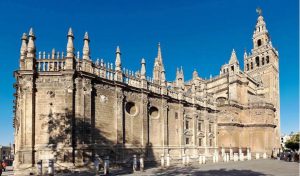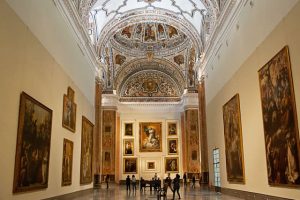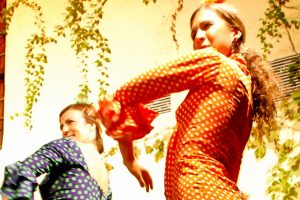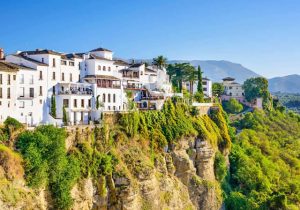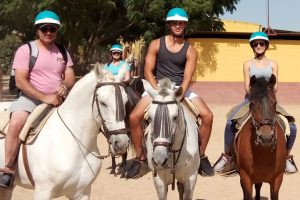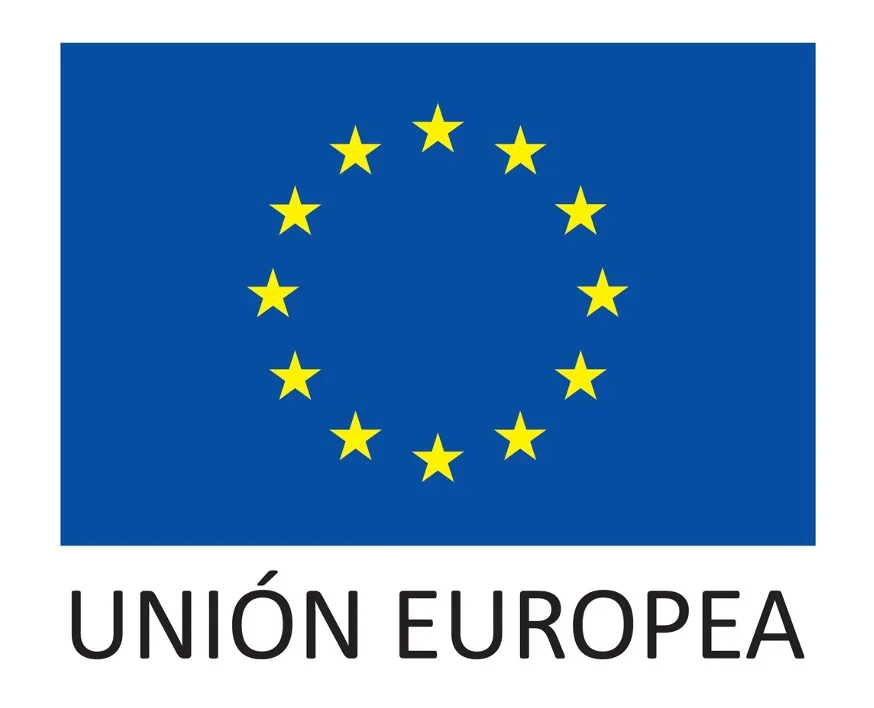The Cathedral and Giralda
of Sevilla
The Cathedral and Giralda of Seville
Built in the 15th century, it is the largest Christian temple, in decadent Gothic, in the world. Her real name is Santa María de la Sede .
It has been declared a World Heritage Site since 1987 and is one of the most visited in the city of Seville.
It is located on the land that was once occupied by the Great Mosque of Seville , which was converted to Christian worship after being the city conquered by Fernando III “El Santo”.
Work on its construction began in 1401 after that meeting in the Corral de los Olmos of the living forces of Seville, pronouncing that famous phrase: “Let’s make a church so beautiful and so great that those who see it carved will consider us crazy.” ”.
Although it began to be built between 1401 and 1402, there is no record of documents that tell us about this beginning of works until 1433 on the old aljama mosque, two very emblematic parts of it are currently preserved, such as the Patio de Los Naranjos and the Giralda, another of the most visited monuments in Seville.
Of its builders we know some of the names, and men, who participated in the construction, such as Charles Galter -also called Maestre Carlín- who, as a good master stonemason, came from the area of Normandy in France and had great experience in the construction of great cathedrals.
He arrived in the city after leaving his country due to the Hundred Years War and it has been known that in the month of October 1506 , on the 10th, he placed the last stone in the dome of the Cathedral, that stone that put an end to the construction.
In this way the completion date (1533) is known and the start, although doubtful, is estimated to have been at the beginning of the 15th century.
In 1755 it happened that the Lisbon earthquake affected the construction and minor damage was produced.
To solve all of them, the architects Diego de Riaño, Martín de Gainza and Asencio de Maesa intervened in the reform and reconstruction, as well as, related to the complex, Hernán Ruiz who worked in the second body of the Giralda.
The cathedral dependencies were completed in 1593 as well as the cathedral auctions.
Equally important in the construction of the cathedral, in its decorations, in the hidden symbology, Lorenzo Mercadante from Brittany intervenes decisively, leaving a series of clues on the doors where he intervenes with a message to be discovered.
The periods of the Cathedral
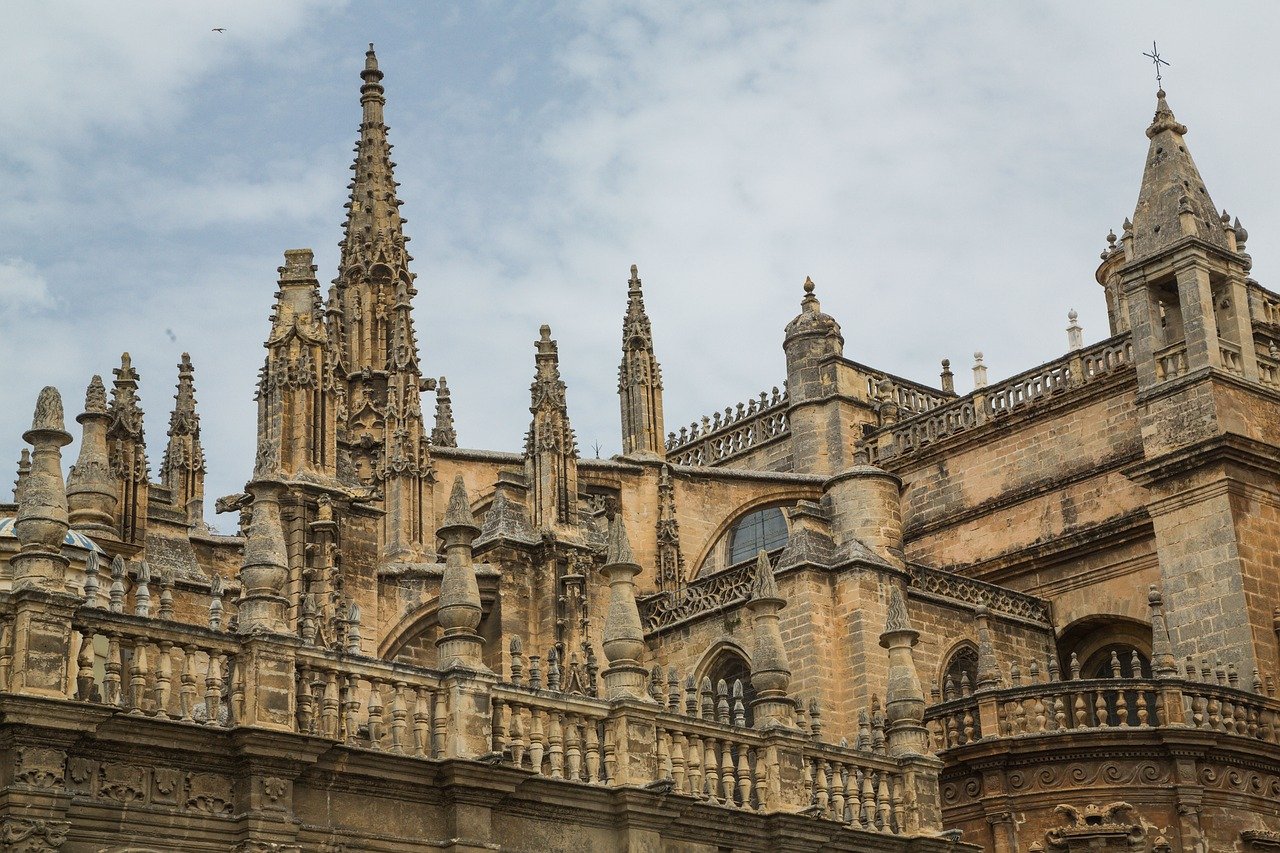
It was the Almohad caliph Abu Yacub Jusuf who ordered the construction of the great mosque in Seville, between April 1172 and March 1198, was officially inaugurated on April 30, 1182, these works being carried out by the architect of Andalusian origin Ahmad Ben Baso, to whom the palaces of the Buhaira in Seville.
It is said of that mosque that it had a floor plan of 113 x 135 meters and an area of more than 15,000 m², 17 naves with horseshoe arches and a beautiful courtyard, of which the Patio de los Naranjos with its Christianized access door, which is the Puerta del Perdón.
After the Almohad period we find the Mudejar, which goes from the year of the Reconquest in 1248 to 1401 . The mosque became a “major mosque” consecrated to Christian worship.
In the Cathedral are the remains of kings such as Fernando III “El Santo” , Beatriz de Suabia as well as his son King Alfonso X “El Sabio” .
For a century and a half, the mosque functioned as a cathedral until its poor state of preservation and the epidemics that devastated the city made it advisable to build a large temple.
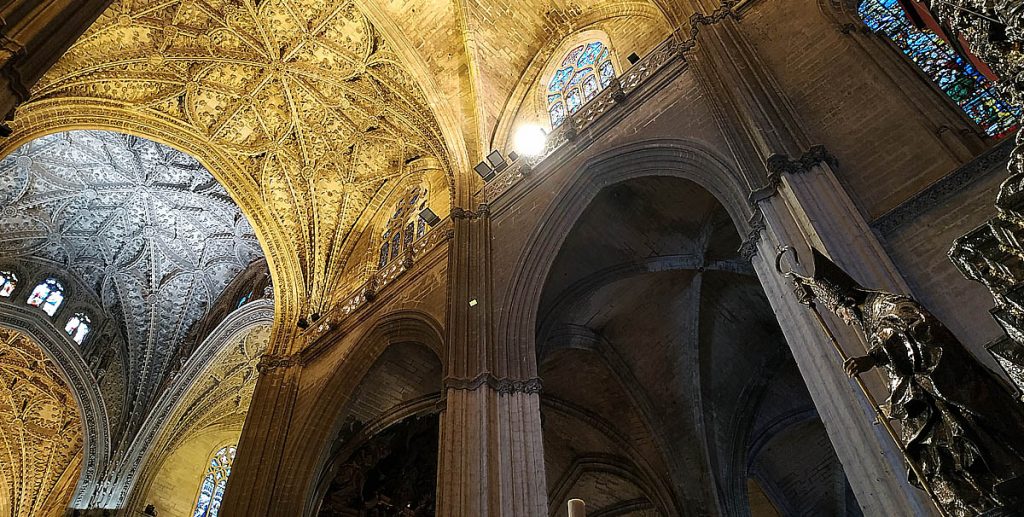
It is the third stage of the cathedral, the third period, when that famous July 8, 1401 when the authorities and canons said the aforementioned: “Let’s make a church so beautiful and so great that those who see it carved will consider us crazy” and, according to the capitulary act, such a great construction should be “such and such a good one, that there is no other like it”.
The cathedral project was carried out by the master Alonso Martínez , continued by the master builder Ysambarte and the Frenchman Carlín.
The Cathedral has suffered damage throughout its history, such as the one caused on December 28, 1511 when one of the pillars collapsed and the dome that covered the transept fell, the architect Juan Gil de Hontañón, followed the work and also the stylistic line designing a new dome completed in 1519. The dome falls again 370 years later, on August 1, 1888, being rebuilt by the architect Joaquín Fernández.
From the Renaissance period, in 1528, we have the Main Sacristy, the Chapter House and the Royal Chapel and the Sacristy of the Chalices and the Alabaster Chapels were completed. Names such as Diego de Riaño, Martín de Gainza, Asensio de Maeda and Hernán Ruiz are located here.
From the Baroque period, between 1618 and 1758 , there is the Sagrario church, the work of Miguel de Zumárraga, framed in the cathedral but independent from it.
In neoclassical style we have dependencies in the temple, overlooking the area of the avenue of the constitution and the Archivo de Indias . The Cathedral had a series of annex buildings that were demolished between 1762 and 1797.
It also has a neo-Gothic part, which goes from the years 1825 to 1928, although efforts were made to maintain its style and respect the decadent Gothic of its construction. In stage highlights the work of the architect Demetrio de los Ríos in 1866 and that is visible in it. Adolfo Fernández Casanova, between 1895 and 1917, completed the gates of La Concepción and San Cristóbal or del Príncipe.
As a curious fact to say that in the Monastery of Bidaurreta de Oñate (Guipúzcoa) there are the plans of the Cathedral. There was another copy but they were burned in the fire of San Lorenzo del Escorial.
In the Cathedral, the Metropolitan Council maintains the daily liturgy as well as important festivities such as Corpus Christi with the dance of the Six, the Immaculate and the Virgin of the Kings, which coincides with the name day of Santa María de la Asunción or de la Sede.
In the cathedral of Seville there is also a treasure and carvings of important artistic value as well as the remains of Christopher Columbus, discoverer of America in 1492.
The doors
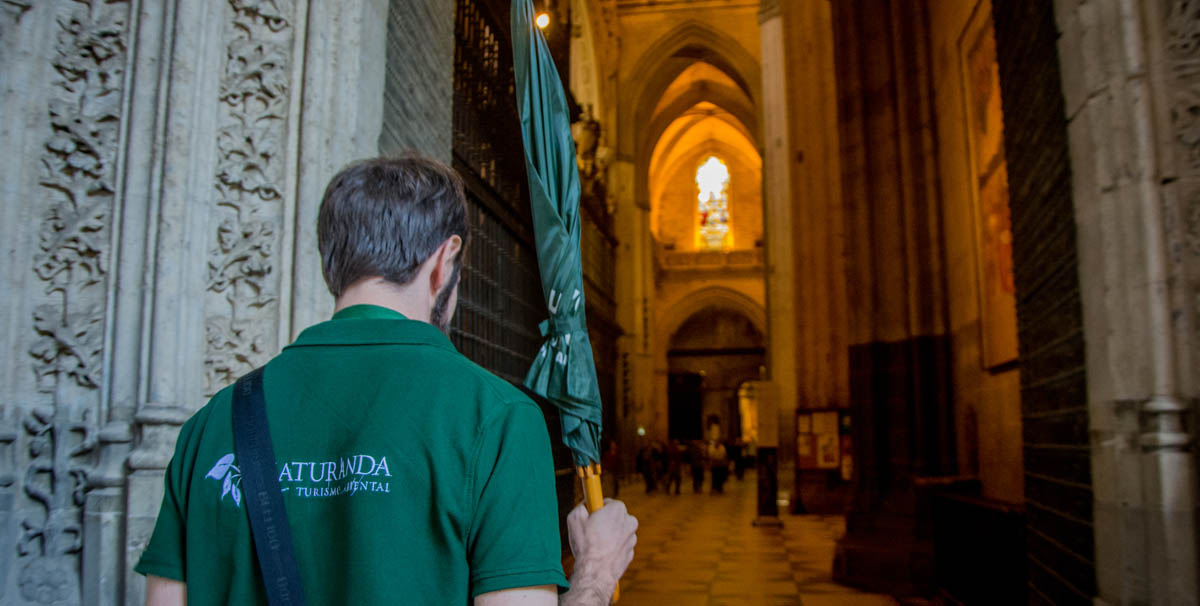
The covers are very outstanding, such as the Baptism, from the 15th century, the work of Lorenzo Mercadante de Brittany. The Cover of San Miguel or the Birth are by Lorenzo Mercadante de Brittany and his disciple Pedro Millán. It is a well-known door because it is where the brotherhoods enter during Holy Week, another of the city’s attractions.
The main portal or the Assumption of the 19th century, the work of Jovellanos and Ricardo Bellver between 1877 and 1898 .
The Puerta de San Cristóbal or del Príncipe is from 1887, designed by Adolfo Fernández Casanova and finished in 1917, the first design is the work of Demetrio de los Ríos. Likewise, the Puerta de la Concepción overlooks the Patio de los Naranjos, designed by Demetrio de los Ríos and finished by Adolfo Fernández Casanova in 1895, respecting the decadent Gothic style.
La Puerta del Lagarto overlooks the Patio de los Naranjos and is named for a “curious” lizard hanging from the ceiling along with other details that are very symbolic and little ornamental.
The Puerta del Sagrario is by Pedro Sánchez Falconete from the end of the 17th century and overlooks the church of the Sagrario.
The Puerta del Perdón has that access to the Patio de los Naranjos from Calle de los Alemanes. It belongs to the old mosque, visible due to its pointed horseshoe arch. The sculptures are by the sculptor Miguel Perrin who is also involved in the Puerta de Palos or the Adoration of the Magi. Its name is taken from the wooden railings that separate it from the old dependencies of the cathedral chapter.
La Puerta de Campanillas is so called because it was the one that served to call the workers, it represents the entrance of Christ to Jerusalem, also Miguel Perrin.
Highlights of the Cathedral are its chapels, its imposing high altar, the beautiful stained glass windows, the choir or, simply looking at the ceiling and contemplating the finishes, the ribs of the vaults.
The interior of the Cathedral of Seville
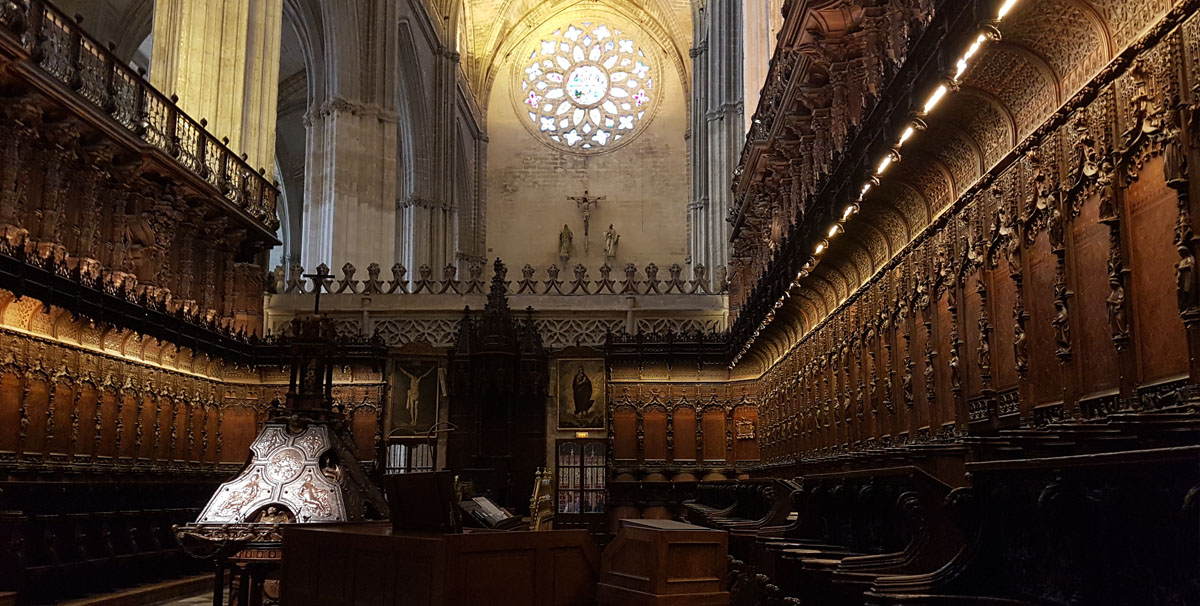
If there is a place that stands out among all the places that we can see in the Cathedral, that is, without a doubt, the main altar, initially designed by Pedro Dancart , 20 meters high by 18 meters wide, divided into 7 vertical lanes, stands out the central double width, 4 bodies high, equipped with a bench in the lower part. Very rich ornamental work with 28 scenes from the life of Jesus Christ and the Virgin Mary.
But in the year 1550 the council decides that it must have two lateral streets on each side located at right angles attached to the initial set and this originated a new carving work of 16 new reliefs with scenes from the old and the new testament, being a total of 44.
Inside the Cathedral, the main altarpiece is very prominent in the central nave and in a marked Renaissance style, being highly valued within the History of Art. It was carried out in the year 1482 in which artists of the stature of Pedro Dancart, Jorge Fernández Alemán, Roque Balduque and Juan Bautista Vázquez el Viejo participated, who carried out the crucifixion of the Million, in the fifteenth century, and who, in the city, also among others, he made the image of Christ of Burgos. In this altarpiece there is an image of the Virgen de la Sede from the 13th century, who is the patron saint of the Cathedral.
The second phase began in 1550 and was completed in 1564 the work of Roque Balduque, Pedro Becerril, Juan de Villalba and Diego Velázquez, who was not the Sevillian painter although he shares the same name; it was added in 1552 Pedro Bernal, Juan Reclid and Luis del Águila in 1553, in 1554 Pedro de Heredia, Juan López, Andrés López del Castillo and in 1555 the sons of Andrés López del Castillo.
The magnificent Royal Chapel is the “head” of the Cathedral with a characteristic square floor plan with an apse and two side chapels. If we look up we will see the beautiful hemispherical dome and lantern from the period of 1567 and 1569, the work of Hernán Ruiz el Joven.
At this point we find the pantheon with the impressive silver urn of King San Fernando in an exceptional work by Juan Laureano de Pina in baroque style. We also find the tombs of Alfonso X of Castile and his mother, Queen Beatrix of Swabia. We also find the remains of Pedro I of Castile and his wife, Queen María de Padilla, presiding over everything is the ivory image of the Virgen de las Batallas, from the 13th century.
In the altarpiece we find the general patron saint of Seville, the Gothic image of the Virgen de los Reyes, at that time patron saint of the city and the archdiocese.
In the Trasaltar the religious sculptures, of saints, in fired clay, on the shelves and under canopies, are of enormous merit, there are 59 in a combination of styles such as Gothic, Renaissance and Mannerist, work of different stages and artists such as Miguel Perrin, Juan Marin or Diego de Pesquera.
Virgen del Reposo, from 1575, with her sleeping Child, possible authorship of Miguel Perrin in front of the gate of the Royal Chapel, many pregnant women entrust themselves to her so that the birth goes well.
There is a legend that tells us that centuries ago a Jew passed by his feet who blasphemed for being the Virgin the origin of Jesus, it is said that he converted to Christianity and repented of everything he said after which he dedicated himself to spreading the devotion to the Virgen del Reposo and the tradition with future women in labor. For all this she is known as Our Lady of Bienpariese.
Doña María Osorio had a great devotion to her and, for this reason, in 1554 she ordered the construction of a chapel or niche to Our Lady of Rest in the center of this entire area, known as the trasaltar, under it is the chapel of Our Lady of Soterraño .
Impressive is the Choir made with stone walls on three sides and which is located in the fourth and fifth vaults of the central nave and the front is closed with a Renaissance-style grille by Francisco de Salamanca in 1593.
The typical stalls of the Choir have 127 seats with marquetry backs in different types of wood that give the ensemble a particular color scheme. All the reliefs of scenes from the Old and New Testaments are very admirable in them. We can see from sweet expressions to hard, grotesque faces.
On the main planks at the entrance to the choir there are ogival motifs separated by columns topped with pinnacles, very much in the Gothic style.
We have three main positions that are those of the archbishop and his assistants in an exceptional artistic ensemble of carving, in one of them we can read: “This choir was made by Nufro Sánchez entallador… 1475”, as a trace of the passage of one of the craftsmen who worked on them as were master Pedro Dancart or his disciple Juan Alemán who completed the stalls in 1511.
In the Trascoro we find another incredible baroque work by Miguel de Zumárraga in 1619, it was concluded in 1635 after a decade of inactivity and very valuable marbles and jaspers were made, it also has the addition of ornaments, in bronze, reliefs and busts and a Gothic painting of the Virgen de los Remedios that presides over it with marked Italian trend in its invoice.
A jewel is its organ, famous worldwide and in operation with a great maintenance work by the conservators of the Cathedral of Seville. It is the authorship of Aquilino Amezua in 1901 and restored by Gerhard Grenzing in 1996. The previous one belonged to Jordi Bosch i Bernat, destroyed in the collapse of 1888, it was one of the best organs in Europe.
The secret of the organ is that it is not one but two and facing each other, they are two twin instruments that sound from the same keyboard simultaneously, as a curiosity to say that it has 15,000 pipes that give it unparalleled harmony.
There are four Alabaster Chapels, small and very unknown, from 1515, by the master Juan Gil de Hontañón and continued by the architect Diego de Riaño, these are the Chapel of the Immaculate, Chapel of the Incarnation, Chapel of the Virgin of the Star and Chapel of San Gregorio.
The Chapel of the Immaculate has an impressive altarpiece by Juan Martínez Montañés, commissioned by Jerónima Zamudio on February 14, 1628, the widow of the jury Francisco Gutiérrez de Molina. It is an Immaculate Conception , in its realization, and due to a lawsuit due to delays, it was when the famous image maker said: “it will be one of the first things in Spain and the best thing that the aforementioned has done”. The image of the Immaculate Conception presides over the altarpiece inaugurated on December 8, 1631. She is popularly known as La Cieguecita because her eyes seem almost half closed, almost closed.
Symbolically she is a Virgin Girl , 164 centimeters tall with a tunic that is very tight and gathered with a girdle that symbolizes that she is a maiden, highlighting the quality of the work of the mantle with multiple folds. On the head a crown with twelve stars in reference to the twelve tribes of Israel. At his feet, on the base, the faces of three angels on a dragon symbolizes sin. Capilla de la Encarnación has an imposing altarpiece by Francisco de Ocampo y Felguera from 1630 orbiting around The Annunciation, the images of San Juan Bautista, San Juan Evangelista, Santo Domingo, San Francisco and San Antonio draw attention.
In the Chapel of the Virgen de la Estrella we find a Renaissance image of the Virgin, possibly the work of the Gallic Renaissance sculptor Nicolás de León , from 1530; the baroque altarpiece is by Jerónimo Franco from 1695.
The Chapel of San Gregorio has an image of the saint carrying a book, as a curiosity to say that in it you can see the signature of its author Manuel García de Santiago from the 17th century.
In it Altar of Magdalena we find the patronage of Pedro García de Villadiego and his wife Catalina Rodríguez, from 1537, an anecdote that we find is that both appear represented in the altarpiece (much to the taste of the time), as well Don Pedro is next to San Benito and Doña Catalina next to San Francisco.
The motif it represents is The Annunciation in the attic and The Magdalene at the feet of the Risen Christ with paintings by an anonymous disciple of Alejo Fernández from 1537.
The stained glass window by Arnao de Flandes is exceptional, located next to the altar, where we can appreciate, in a colorful way, Saint Sebastian with the face of Emperor Carlos I. A new curiosity in the Cathedral is the duplicity of this altar, since there is another one on the north side of the transept nave of the Cathedral.
In the center of the altarpiece the relief with representation of the Assumption of the Virgin with paintings of San Ildefonso and San Diego de Alcalá. The patrons of the same are found in the banks, they are Juan Cristóbal de la Puebla and his wife who endowed it in 1593.
The Chapel of San Andrés stands out for the impressive carving of the Cristo de la Clemencia by Juan Martínez Montañés , in 1603, or Cristo de los Cálices, and a clear exponent of baroque sculpture, very serene and with the detail of having 4 nails fixing the crucified to the log.
We found the Gothic tombs of Alvar Pérez de Guzmán, his father, his wife, Elvira de Ayala and their son, as well as a painting of, presumably, Lucas Jordán from 1700 in which we can see “The transfer of the Ark of the Covenant” and “The Canticle of the prophetic Mary” in thanksgiving after crossing the Red Sea. In the upper area, there is a copy of the Martyrdom of Saint Andrew, by Juan de Roelas, and the original can be admired in the Seville Museum of Fine Arts.
There are many other points of interest inside the Cathedral but, finally, it could not be done in any other way than visiting the tomb of Christopher Columbus where his remains rest.
His last resting place is from the heights provided by four monumental pages that represent the four kingdoms of Spain that existed during the lifetime of Columbus, these are: Castilla, León, Aragón and Navarra.
The tomb was one of the last additions to the Cathedral, being located in 1899 under the design of the sculptor Arturo Mélida. Few know that, originally, it was located in Cuba , in Havana and was transferred to Seville after the loss of the colonies in 1898.
Columbus died in Valladolid in 1506 being transferred to Seville by order of his brother Diego. In 1542 his remains were transferred to Santo Domingo (Dominican Republic), in the Cathedral of Santa María , where they remained for 200 years to go to Cuba until 1898 when they returned to Seville.
The Cathedral of Seville is a monument that is visited by millions of people a year, in the historic center of the city and close to such emblematic places as the Barrio de Santa Cruz or monuments such as the Reales Alcázares or its inseparable Giralda. Contemplating everything it has to offer the visitor is a delight for the eyes and the soul, as could not be less in a temple of this category and significance. A must for every visitor.
Giralda, the Tower of Seville
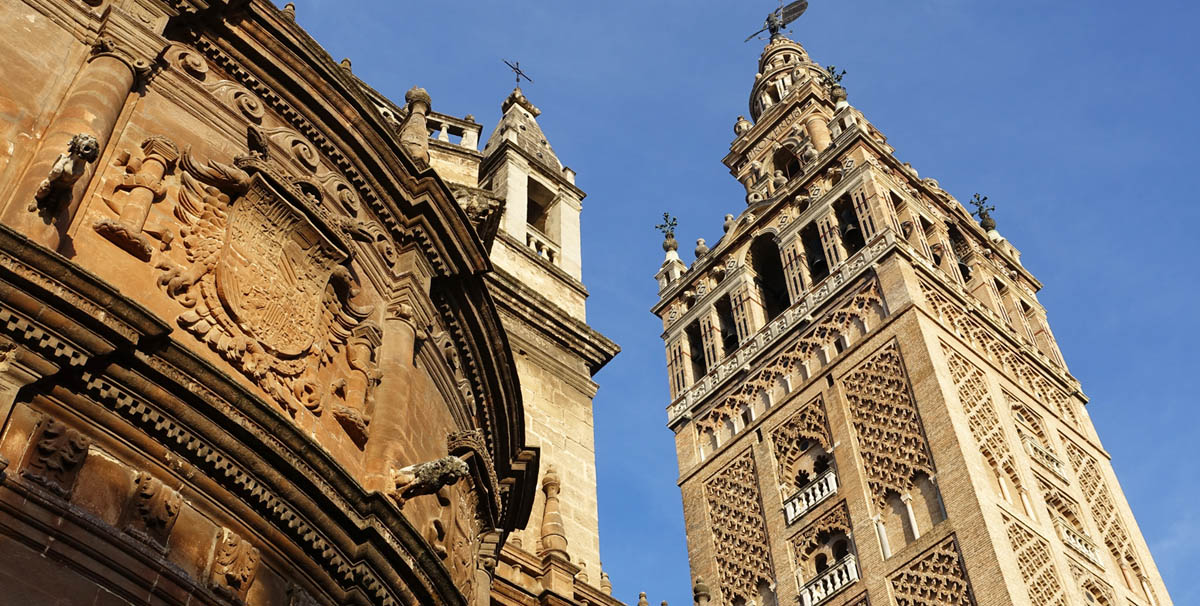
The Giralda is the most characteristic monument of the city of Seville, located next to the Cathedral and being the perfect bell tower of the same.
It has a curious past that has led it to be a stylized symbiosis of Muslim and Christian culture.
The Tower of Seville has an Arab past where it was an old minaret that was located next to the Great Mosque at the end of the 12th century. Thus, two thirds of it are of an Almohad character while the entire upper part is of Christian architecture as it was the base of the bell tower that can be seen today.
Topping off the tower is the sphere on which the most representative element of the tower rests, such as the figure of the Giraldillo . -with dimensions of 7.69 meters- which, really, represents the Triumph of Faith and which is a weather vane, it is precisely the figure that gives its name to the tower, since as a weather vane it rotates and from that rotation, at the mercy of the wind, it is the Giraldillo and from this the Giralda.
You have to know about it that until not too long ago it was the tallest building in Andalusia with its 104.1 meters high . Compared with other monuments in Europe, for comparison, we find that the Tower of Pisa (Pisa, Italy) measures 55.8 meters or Big Ben (London, United Kingdom) which is 96.3 meters.
It has state protection when declared, on December 29, 1928, National Heritage and in 1987 as a World Heritage Site.
Giralda Periods

Being Seville capital of Al-Andalus we have that a stage is the one in which the construction of the most characteristic buildings of this stage takes place, of it is the main mosque that replaces the one that was in the Plaza del Salvador , it was the century XII, the year 1172.
It was the caliph Abu Yaqub Yusuf who ordered, on May 26, 1184, the construction of the mosque’s minaret. With the death of Yusuf, the project continues under the mandate of his son and new caliph, Abu Yúsuf al-Mansur (Muminin).
On August 10, 1184 , the original project that was to keep the minaret connected to the walls of the citadel was continued. In its foundations there was a depth of 3.60 meters that today is visible the part of 3 meters of masonry that comes out of the sidewalk plus a series of marble altars from Roman times that are very visible at its base.
Around March 2, 1188 and February 18, 1189, the works stopped when Ibn Saíd, who was the almojarife in charge of recording expenses, was dismissed and Abu Bakr replaced him. The contribution of the master builder Ali al-Gumari (Alí de Gomara) and the death of Ibn Basó stand out in the construction. At this time it was decided to continue with the works of the minaret with brick from the stone plinth, although there were many interruptions in its construction.
would be the June 19, 1195 when the emir Abu Yaacub al-Mansur defeated the Castilian king Alfonso VIII in Alarcos and on his return to the city, he ordered the placement of some large gilt bronze spheres that finished off the upper part of the minaret, being placed on March 10, 1198.
These were the popular “four apples”, the yâmûr , which were inserted into a log and whose brightness was said to be seen from 40 kilometers away.
The Giralda Bodies
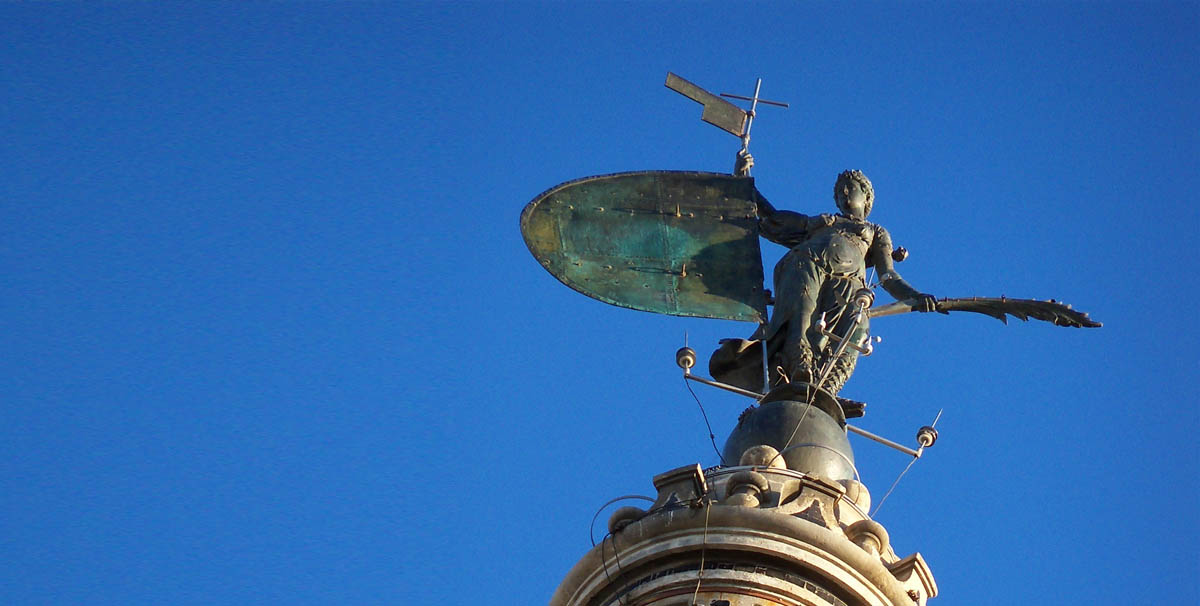
Among the bodies, the first one stands out with 50.51 meters high and a square floor plan of 13.61 meters wide. The second body was 14.39 meters high and its floor plan was square, 6.83 meters wide, topped with a dome and on top of it the yâmûr
When the city was conquered by Ferdinand III “the Saint”, in 1248, it was decided to consecrate the mosque as a Christian temple and replace the yâmûr in the tower to put a cross and, under it, a weather vane, although it is true that the yâmûr it was not withdrawn.
On the occasion of the earthquake of August 24, 1356 , the belfry with the “four apples” fell and it was decided to put a bell and a cross in its place, since it was already the original bell tower.
As a curiosity, it should be noted that the tower, the minaret , was about to be demolished because it does not appear in the original plan -the only one that is preserved of the cathedral- in which it did not appear but was not destroyed for two reasons: economy and rush to inaugurate the Christian temple.
Another curious detail is that the Giralda was decorated by a series of paintings such as the frescoes by Luis de Vargas dating from 1553 to 1558, so under the first balcony we find the Annunciation (north face), in the areas of stucco that escort to that balcony we would find San Isidoro and San Leandro and the Saints Justa and Rufina to the other. Above Christ Crucified with the Virgin Mary and Saint John the Evangelist as well as other paintings of saints.
It has also been discovered, in recent restorations, that it had polychrome decorations with reddish tones that would have been lost over time.
Hernán Ruiz would be in charge, in 1556, of replacing Martín Gaiza and that he would renovate the tower by adding a body of bells.
It is said that the Giralda has other twin towers like the one found in Marrakech, Koutoubia or Rabat, but these are made of masonry and the Giralda is made of bricks.
bell names
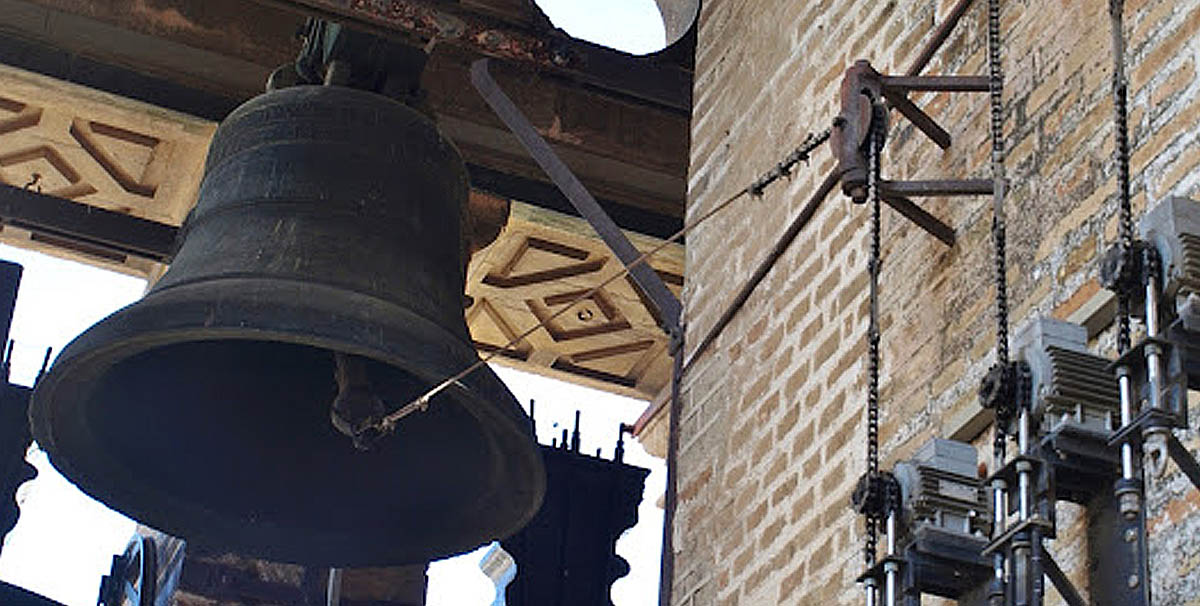
Among the bodies of the Giralda we have:
- 1.- Body of bells.
- 2.- Clock body.
- 3.- Body of the stars.
- 4.- Body of the carambolas.
- 5.- Plume.
- 6.- Sphere.
- 7.- Giraldillo.
You can also read the legend or inscription: “TURRIS (E) – FORTISSIMA (S) – NOMEN DNI (O)- PROVERB” (“The strongest tower is the Name of the Lord”).
Striking with the jars of lilies, the work of the foundryman Bartolomé Morel on February 28, 1568, made of iron and bronze, designed by Hernán Ruiz inspired by an artifact to study the winds called aeolipiles.
All the bells of the Giralda they have a name, there are 24 in total, 18 of them with tumbling, 6 with clappers and it is the cathedral that has the most bells in Spain; 13 have male names, the holy men: San José, San Sebastián, San Laureano, San Isidoro, San Hermenegildo, San Juan, San Pablo, San Pedro, San Fernando, San Juan Bautista, Santiago, San Cristóbal and San Miguel); 9 of women: Santa Cecilia, Santa Justa, Santa Rufina, Santa Lucía, Santa Florentina, Santa Bárbara, Santa Inés, Santa Catalina and Santa María la Mayor); the remaining two are those of All Saints and the Holy Cross.
The largest of all, that of Santa María la Mayor , weighs 5,362 kg and the smallest, that of Santa Cecilia, 138 kg. The oldest bell is from the 15th century (that of Santiago is from 1438), the most modern six that were recast in 1998.
José Gestoso in “The venerable image of the Virgen del Olmo with historical news from the tower of the holy Cathedral Church where it is located”, which reads as follows:
“From this part begins the Greco-Roman work that consists of three architectural bodies, the first has its four facades the same width as the tower, it is where the bells are located. Inside, under the middle arch that looks north, and is the main face, is the Mayor, called Santa María ; and behind him, on the front facing south, is the second, called San Miguel, in the same way. In the four angles, there are as many in this way: to the right of the Mayor, Santiago; to the left, Santa Cruz. The others, on the north façade, Santa Ruina, San Hermenegildo; the Mayor, Saint John the Baptist and Saint Lucia; in the east, San José, San Laureano, San Pedro, San Juan Evangelista and Santa Inés. At noon, Santa Bárbara, San Isidoro, San Miguel, San Pablo and Santa Cecilia; to the West, Santa Justa, San Fernando, San Cristóbal, San Sebastián and Santa Florentina. The Clock is called San Miguel de las Victorias , and completes the number of the twenty-five; and in one of the four arches that have the second body, which is where it is, is also the Matraca, which is played only on Holy Thursday, Friday and Saturday”.
Replicas of the Giralda
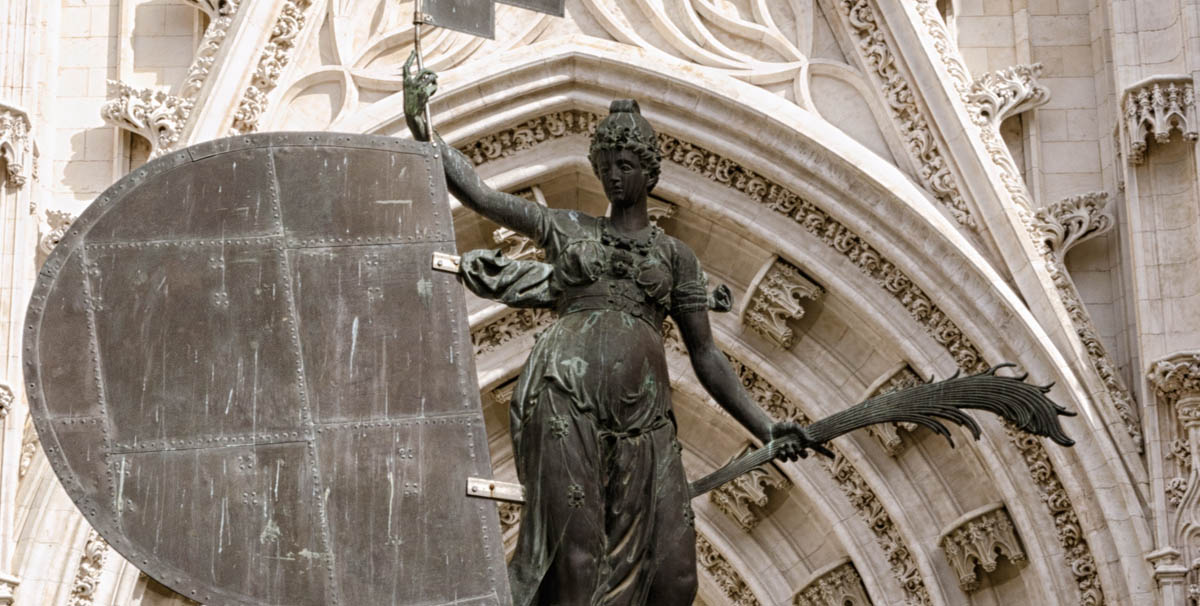
We find replicas of the Giralda in the Tarragona town of Arbós, Carmona, in Badajoz, in Kansas, in Miami, the disappeared one in New York (United States), Leuven (Belgium) or in San Juan de Puerto Rico (Puerto Rico).
Do you want to book a guided tour in Seville? Perfect, we offer you more than 30 different visits Guided Tours of Seville .

